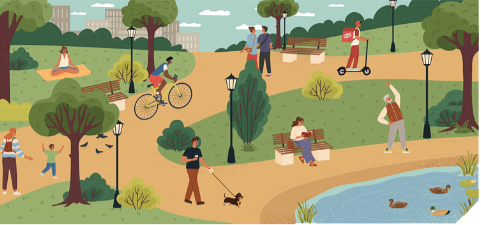What Is Driving the Demand for Bike and Pedestrian Park Space?
By Jordan Gedrose

In recent years, there has been an increase in demand for bike and pedestrian park spaces across the nation, which has also become prevalent in cities across Minnesota. The trend reflects a shift in societal values. There are several factors we are seeing connected to this trend, including public engagement influencing demand, recognition of bicycle and pedestrian park space benefits, and the effects these types of park spaces have on city infrastructure.
Public engagement
Public engagement is increasingly encouraging communities to prioritize investments in bicycle and pedestrian park space, reflecting a growing interest in recreational spaces and active transportation corridors. As community members and stakeholders become more vocal about their desire for healthier, safer, and more sustainable communities, decision makers are responding by allocating resources to expand and enhance infrastructure for cyclists and pedestrians.
Advancements in technology, such as social media, have provided new methods to collect citizens’ feedback and has led to an increase in community engagement participation. These methods allow cities to notify community members about opportunities through a variety of channels, which reach a high percentage of the people in each area. Online interactive maps, comment boards, and virtual meetings — methods spurred by the COVID-19 pandemic — allow for greater participation and input than only hosting in-person events.
The pandemic also underscored the importance of outdoor spaces for recreation and social distancing, while also emphasizing park spaces and trails that cater to diverse user groups. By engaging the community, cities and counties can clearly understand needs and are better prepared to provide meaningful bike and pedestrian experiences.
Health benefits
Bicycle and pedestrian park spaces offer a multitude of benefits that contribute to the health, activity, and environment of a city. Regarding health: bike and pedestrian park spaces promote physical activity and healthier lifestyles by providing safe and accessible trails for walking, jogging, and cycling, which can lead to a reduction in the risk of chronic diseases such as obesity and heart disease. These spaces are designed to be accessible to all age groups and abilities. Research provided by City Parks Alliance found that walking loops increase park use by 80%.
Connectivity
Infrastructure that allows bicycle and pedestrian park spaces fosters connectivity between neighborhoods, business districts, and recreational areas — enhancing overall mobility and accessibility for residents and visitors alike.
Communities, big and small, are experiencing improved connectivity, heightened accessibility to amenities, and a revitalization of public spaces spurred on by bike and pedestrian focused infrastructure. Properties located near parks and trail corridors typically attract investment, as parks and trails are often viewed as desirable amenities that enhance quality of life and contribute to a higher standard of living. According to City Parks Alliance, houses near parks or trails have 8-10% higher property values than those in the surrounding community.
Bike and pedestrian park spaces contribute to the creation of vibrant and inclusive communities by providing opportunities for social interaction and recreation — fostering a sense of belonging and connection among residents. These spaces provide opportunities for people to connect with nature, even in urban environments, which has shown positive effects on mental well-being and reducing stress.
Environmental factors
In regard to the environment, prioritizing bike and pedestrian infrastructure promotes active transportation and encourages residents to opt for emission-free modes of transportation, reducing traffic congestion and greenhouse gas emissions. By promoting active transportation and reducing reliance on cars, bicycle and pedestrian park spaces contribute to more sustainable and resilient cities, with improved mobility, accessibility, and environmental stewardship. Bicycle and pedestrian corridors also provide habitat corridors for wildlife, contributing to the biodiversity within a community.
Notable challenges
While these spaces offer many benefits, a few challenges of incorporating bicycle and pedestrian infrastructure may include funding, maintenance, site constraints, and community opposition. The expansion of bicycle and pedestrian park space significantly impacts city infrastructure, ushering in a wave of changes to communities.
Cities across Minnesota are seeing an increase in demand for bicycle and pedestrian park space attributed to an increase in community engagement participation and acknowledgement of the health, recreational, and environmental benefits. Cities have continued to adapt to this evolving infrastructure demand through comprehensive planning efforts and investment in park and trail infrastructure. By implementing these improvements, communities can enhance their quality of life for residents and position themselves as an attractive destination for tourists.
Jordan Gedrose is a landscape architect at WSB (wsbeng.com). WSB is a member of the League’s Business Leadership Council (lmc.org/sponsors).

